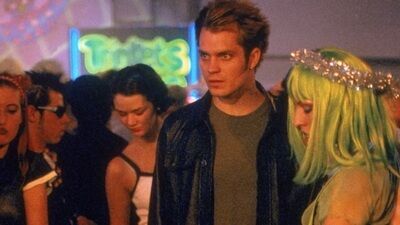
[ad_1]

The unexpected global success of “Pulp Fiction” in 1994 spawned a wave of wannabes and cash-ins, many of them mixing and matching elements that they thought made Quentin Tarantino’s movie a success: Violence, drugs, ostentatiously declamatory dialogue and monologues, time-shifting stories. Of course, the real reason for its success was that it had a singular voice that a lot of people hadn’t heard before, which meant that attempts to quantify it as a commercial formula were mostly doomed to failure.
A conspicuous exception—creatively, anyway—was 1999’s “Go.” The film was written by John August (“Big Fish”) and directed by Doug Liman, whose debut feature, 1997’s “Swingers” made rising stars of its two lead actors, Vince Vaughn and Jon Favreau (who also wrote it). Seen today, “Go” is as much of a time capsule as “Pulp Fiction,” though arguably of greater historical interest, because it focuses on characters who could actually exist, and is set in the world of striving, mostly young people partying and scheming and getting into trouble in Los Angeles and Las Vegas right before the turn of the millennium.
It’s an ensemble film, but Sarah Polley, who later went on to a notable career as a director, is definitely the star, projecting what initially seems like just a surly and shallow teenage energy that morphs into something bleak and desperate. The mix of anger, hunger, and sadness in her performance is a dark anchor for this swirling movie. Her character Ronna— like many of the other major characters in the first segment, she’s a supermarket employee –is on the verge of being evicted from her apartment over unpaid rent when she agrees to take over a shift from a young Brit named Simon (Desmond Askew) so he can go to Vegas to party with his buddies.
Zack and Adam (Scott Wolf and Jay Mohr), a couple, show up on the day that Simon was supposed to be working, asking for him. It turns out that he’s their drug dealer. They hoped to buy 20 hits of ecstasy from Simon before attending a rave party that night. Looking to make the money she needs for rent, Ronna impulsively says she’ll get them the drugs.
And it’s here that things get complicated, for Ronna and for the film. After getting the ecstasy from a dealer named Todd (a blonde, often shirtless Timothy Olyphant, in Young Jack Nicholson mode), Ronna pushes her coworker Claire (Katie Holmes) to stay in Todd’s apartment as collateral because she doesn’t have enough money to buy the pills outright and has to sell them and then return to settle her debt. But Zack and Adam are with a handsome but creepy guy named Burke Halverson (William Fichtner) who sets off her danger alarm. Ronna clocks him as a cop, dumps the drugs in his bathroom toilet, and replaces them with aspirin from a local pharmacy, which makes an enemy of Todd when he discovers the ruse.
Then, after a genuinely surprising incident of violence, the movie pivots to pick up the story of Simon in Vegas, then returns to Los Angeles for a truly bizarre interlude with Zack and Adam and Burke and his wife Irene (Jane Krakoski), who try to pull Zack and Adam into a multi-level marketing scheme. The structure of “Go” is fascinating. It’s somewhere between a time-shuffled linear feature and a collection of interlinked short films, but the repetitions of certain scenes and actions (often but not always from new perspectives) changes our relationship with them, as well as our understanding of what they mean in the greater scheme. Much of the humor is pitch black, and there’s a long sequence involving a, shall we say, problematic wardrobe choice by Fichtner’s character that remains one of the funniest sustained bits of mind-effery that I’ve seen in a movie.
Liman’s direction is, as always, lively and nimble. He has a lot of fun messing around with the formal properties of the medium, from the opening credits sequence that pairs its gut-rattling music with rave footage that somehow seems to be battling with the soundtrack, through the multiple narrative lines that intertwine and all come together pleasingly at the end. It’s fun to think of this as a prelude to (or workshop for) Liman’s “The Bourne Identity,” which came out three years later and rewrote the rules for action filmmaking to favor whipsaw handheld widescreen camerawork and cutting so fast as to verge on impressionistic.
The cast is practically a yearbook of under-40 actors who were hot from ‘90s independent films and on the cusp of breaking into studio-level features: besides the ones listed, there’s Melissa McCarthy, Tane McClure, James Duval, Taye Diggs, and Breckin Meyer. The great rumble-voiced character actor J.E. Freeman (of “Miller’s Crossing” and “Wild at Heart”) shows up to put the fear of God in viewers just by looming and narrowing his eyes.
The movie captures the bright, chaotic, liberating, kinetic energy of a rave (by design) but also has an undertone of lament (surely incidental, because who knew?) for the 20th century analog/material world that was about to get left behind once the Internet became ubiquitous in the aughts and digital facsimiles of places and people began to seem more real than reality. This is a stealth classic movie, all the more impressive for having so many moving parts but setting them in motion without fuss and keeping them going until the clockwork-perfect ending. The movie year 1999 produced an incredible number of good to great films. This is one that doesn’t get talked about as often as it should.
[ad_2]
Chidera
Hmmm
Ahmed Ibrahim
Truly speed kills
Victor osuhon
Interesting